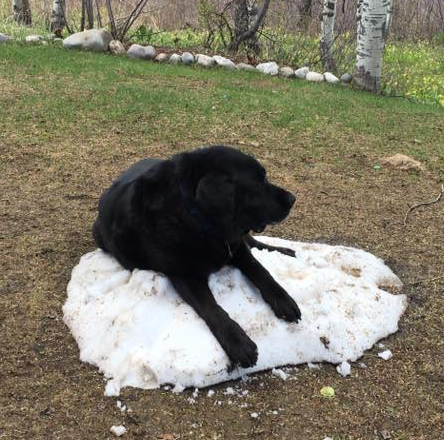What Does It Mean? “Is Your Dog Cool-Seeking?”

Is Your Dog Cool-Seeking? Traditional Chinese Veterinary Medicine Wants to Know
A Traditional Chinese Veterinary Medicine (TCVM) doctor will ask, “Is your pet heat-seeking or cool-seeking?” You might just think, “What do you mean?”
The dog in the picture makes his point obvious: of all the places in the yard to lounge, he lays on the block of icy snow that has not yet melted in the Spring thaw. There are obvious signs that your dog is excessively cool-seeking.
Signs your dog is cool seeking
Your dog may show one or more signs:
- Lays on cool tile floors, even if it means they are away from the family
- Takes a long time to cool down after going outside in the heat
- Pants for no reason most of the day
- Symptoms seem worse in the evening: coughing, limping, restlessness, itchiness may be worse in the evening
- Drinks more water than usual, often going back for more many times a day
Tru Tip: How much is too much water?
Many people ask Doc Truli this question. A general guideline is 30 mL per pound (1/2 kg) of dog per 24 hours is a maintenance amount of water for an average activity house dog. So a 50 pound (25 kg) dog may drink a liter and a half. If you are in America- think of a 1 1/2 of a liter water bottle to get an idea of how much water that is. (The test of the world knows how much already…) Your veterinarian can help you determine if your dog’s water intake makes sense given their lifestyle and activity level.
Measure how much water your dog drinks for 3 random days and average the amount. If it seems much more than we just described, let your vet know. If your pet seems sick, see the vet right away and measure the water after the consultation.
- Likes to sleep in front of the fan or air-conditioning registers
- Used to sleep in bed with you, now throws off the covers or moves to the cool floor instead
- Usually an older pet
- Often a pet with Diabetes Mellitus, Cushing’s Disease or other endocrine or hormonal imbalances
- May have hot dry nose and ears, may have dry red tongue
- May still sun-bathe for a few minutes a day. The sun offers benefits that out-weigh your pet’s desire to cool off.
If you notice these signs, notify your veterinarian right away. To find a TCVM practitioner near you go to The Chi Institute Directory of Practitioners or The American Holistic Veterinary Medical Association Directory.
If you live in the Tampa Bay area of Florida, USA, call Dr Truli to inquire if a house call appointment is available for your area: (727) 228-2265.



Thank you so much for taking the time and caring to share this post! I hope by my reposting it will help to save the lives of our pets who can suffer in silence!